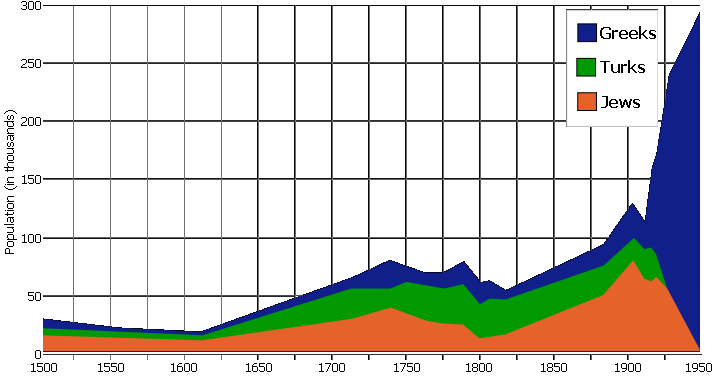






 |  |  |  |  |  | 
|
It was the largest Jewish city in a long period.

This ended after the Greeks took over Salonica in 1912.
The picture above was taken from wikipedia. It is not on this page anymore. Probably because the value of Jews before WWII is incorrect. Present references suggest that at that moment about 40% of the population was still Jewish, which were about 40.000-50.000 people. 96 percent were killed in the Holocaust, see e.g. article in 2017.
Wernieski, A., Plan de Salonique (Copy on a reduced scale of a 1903 French / Ottoman plan of Thessalonica, showing all the synagogues, churches and mosques), Leiden 2003
Macedonian Salonika (Bulgarian: Solun, Greek: Thessaloniki, Turkish: Selânik) was reclaimed from the Ottomans round the year 1900 by Bulgaria, Serbia and Greece. This dynamic port city was known as the Jerusalem of the Balkans. Since the time that Jews and Marranos from Spain, Spanish southern Italy and Portugal sought refuge here the majority of the population has been Jewish. The names of the synagogues on the city plan reveal this history. A census taken in 1883 shows that 56% of the 85,000 inhabitants were Jewish. Of the rest 23% were Turkish-Islamic and 19% Greek Orthodox. Many Slavic-speaking subjects of the sultan lived in the city’s hinterland. About the year 1900 the city had 32 synagogues, 32 mosques and 18 churches.
The names of the synagogues are as follows: 1. Nevee tsedek (Dwelling of justice, from Calabria), 2. Kiana (from Calabria), 3. Ishmaël (from Calabria), 4. Mayor shenie (Second Majorca), 5. Sicilia chadash (New Sicily), 6. Lisbon yasyan (Old Lisbon), 7. Mayor rishon (First Majorca), 8. Mograbish (from the Maghreb), 9. Yahia (from Portugal), 10. Talmud Tora (the central synagogue), 11. Gerush Sefarad (Expulsion from Spain), 12. Estrug (from Apulia), 13. Bet Aharon (House of Aaron, from Sicily), 14. Nevee shalom (Dwelling of peace, from Calabria), 15. Lisbon chadash (New Lisbon), 16. Ets-ha-chayim (Tree of Life, from Byzantium), 17. Castillia, 18. Ashkenaz (from central Europe), 19. Catalan yasyan (Old Catalonia), 20. Sicilia yasyan (Old Sicily), 21. Aragon, 22. Italia yasyan (Old Italy), 23. Portugal, 24. Shalom (mixed), 25. Italia chadash (New Italy), 26. Italia shalom, 27. Pulia (Apulia), 28. Har gavoa (High mountain, from Apulia), 29. Provencia (Provence), 30. Otranto, 31. Catalan chadash (New Catalonia), 32. Evora (from Portugal).
If we group the origins of the 32 synagogues, we get 11 from present day southern Italy (4 Calabria, 1 Otranto, 3 Apulia, 3 Sicily), 3 from Italy (probably north of Rome), 5 from Portugal (2 Lisbon, 1 Evora and 2 Portugal general), 7 from present day Spain (2 Mallorca, 1 Castilla, 2 Catalonia, 1 Aragon, 1 Spain general), 1 Provence, 1 Ashkenaz, 1 Maghreb, 1 Byzantium, 1 mixed and 1 central.
The data was used from the siger.org website.
Another nice article is by Albertos Nas